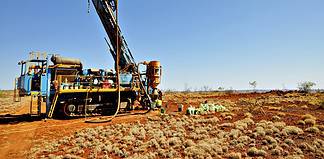Wet tabling of scheelite from Mulgine Hill to produce a bulk sample of tungsten concentrate (under UV light). Image: Tungsten Mining.
BY ELIZABETH FABRI
DEMAND is beginning to pick up for tungsten as China – the world’s largest producer and consumer – begins to scale back production, leaving Australian near-term producers in the box seat. We chat with Australian explorers Tungsten Mining and Thor Mining about their respective projects, and outlook for the year ahead.
Tungsten is one of the lesser-known commodities, but its reach extends to a number of modern electrical applications, including the vibration device in our mobile phones.
The strongest natural metal on earth has been predominately mined in China, and Europe, up until now, and used in the manufacturing sector for machine tools, a toughener in steel alloys, as well as in ammunition and armour.
Yet despite it varied uses, the commodity had experienced a period of volatility over the last 10 years, including two significant lows in 2009, and 2015/16.
Demand was expected to increase modestly, though, according to Tungsten Mining chief executive Craig Ferrier.
“A sustained recovery took shape in mid-2017 with tungsten being one of the best performed metals through that year and into 2018,” Mr Ferrier said.
“The benchmark price for tungsten, ammonium paratungstate (APT) reached a four-year high of $350/mtu (an mtu is 10 kg of metal) in June 2018 with improving demand and tight supply amid environmental inspections in China cited as key drivers for the price increases. “The APT price softened through the back end of last year and into 2019, but market analysts remain optimistic for price improvement as demand and supply re-balance post the Chinese New Year.”
Tungsten Mining has a portfolio of tungsten projects in Australia at various stages of development, including its flagship Mt Mulgine project in WA, followed by Big Hill and Kilba also in WA, the recently acquired Watershed project in QLD, and a potential acquisition of the Hatches Creek project in the Northern Territory.
Mt Mulgine was Tungsten Mining’s most advanced project, with a detailed review underway, which would allow for a decision on the production schedule, scale of activities and additional study work required to deliver the development.
Mr Ferrier said the market was looking well balanced for tungsten over the next few years, with new supply coming on stream in Europe that would, to a large extent, replace metal units from the closed Wolf Minerals’ Drakelands mine in the UK.
“Any pick up in global demand or impact from environmental inspections in China are likely to effect the demand/supply balance and have the potential to push prices higher,” Mr Ferrier said.
Thor Mining executive chairman Mick Billing agreed, citing that a relatively modest change in the supply/demand dynamics could result in a disproportionate change in pricing.
“Pricing levels in 2011 were very high, then in 2015 they slumped to very low levels,” Mr Billing said.
“This probably prevented us from securing project finance around that time.
“We have emerged, however with a more robust project, and a longer mine life.
“Hopefully 2019 is our year.”
Thor Mining was developing the Molyhil project in the Northern Territory, which once operational would have an open pit mine life of seven years with opportunities for expansion underground.
“Molyhil is shovel ready, we have completed all feasibility and licensing requirements subject to lodgement of a rehabilitation bond with the final Mining Management Plan once finance is secured,” Mr Billing said.
“We are currently in the process of securing project finance and once finance is locked in, the first production is 12 months from then.”
Thor’s other project, Bonya, would act as a satellite mine to Molyhil.
“Once resources have been delineated, and appropriate licensing is in place, we will mine the Bonya deposits and process the ore at Molyhil,” he said.
Mr Billing said analysts predicted 2 per cent annual growth in tungsten demand through to 2028.
“A number of new projects, are in construction, and some, like Molyhil, are poised to meet that demand,” he said.
“Barracuepardo and La Parilla in Spain are both set to commence production in 2019.”
However, the big issues remained with China, which currently accounted for about 75 per cent of global supply.
“Most of their mines are believed to be very mature, quite deep, and with both ore grades and costs heading in the wrong direction for them,” Mr Billing said.
“China has also closed a number of operations for environmental reasons, and those ‘in the know’ expect more of this.
“If all this is correct then tungsten prices are headed north in the medium term.”
But for now, global demand was about 100,000tpa, meaning tungsten was not yet quoted on the London Metals Exchange (LME), and companies couldn’t hedge or forward sell as they may do with other base and precious metals.
“Spot pricing accounts for ~five per cent of global trade, yet it is the mechanism which sets western world pricing,” Mr Billing said.








































